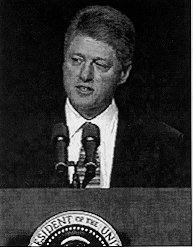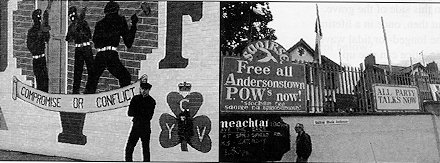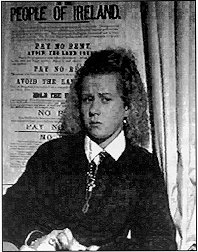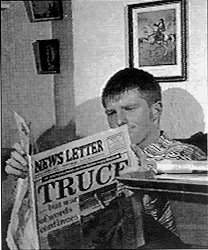CAIN Web Service
Speak Your Piece
Exploring Controversial Issues
OFF THE WALLS
A Guide for Teachers, Youth and Community Workers
|
The Choice
History says, Don't hope
On this side of the grave.
But then, once in a lifetime
The longed-for tidal wave
Of justice can rise up,
And hope and history rhyme.
from The Cure at Troy by Seamus Heaney
The programme highlights the potential confusion between the existence
of a peace process and the existence of peace. Young
people in the studio debate are fairly optimistic about the future.
The drama features the central characters thinking about the possible
outcomes of a ceasefire and the prospects for a lasting peace. |
 |
President Bill Clinton visiting
Northern
Ireland in December 1995. |
| |
Engaging in honest dialogue is
not an act
of surrender. It is an
act of strength and
common sense.
| |
Before viewing...
When the series was being made ceasefires existed in Northern
Ireland (August 1994 to February 1996). Discuss:
- How you felt during the period of the ceasefires.
- How you reacted to the announcement that the IRA ceasefire
had ended.
- What are the hopes and fears for the future within your group?
|
What does the graffiti tell us?
|
|
 |
| |
| Loyalist Mural - Shankill |
Sinn Fein Office - Andersonstown |
 | Activity The series show images of graffiti and wall murals in Belfast. Worksheet 5a on page 24 contains slogans from the programme and activities which examine the use of this form of communication in divided societies.
|
| What effect does violence have on our attitudes to the future?
|
| |
 |
- I suppose that means the war is over. How can you just stop? What about our Frankie and all the rest of them? They're still in jail. Maybe he'll get out. Does that mean we've won or they've won? Imagine if it was all over and our Frankie and all the rest of them were out. (Pat)
- Must be a sell-out to the fenians. Going soft we are. Billy's mother gabbing on about ordinary prods having more in common with fenians from the Falls. What's she on about? We'll not give up. No choice. No surrender. (Ken)
- I don't believe it. It's a dream. They'll not stop. Is the blood stained hand stood still? Ifeel so sad, so sad. (Anna)
- I'll believe that one when I see it. There'd be head-the-balls everywhere trying to keep it going, especially them politicians, they'd be out of a job. The last thing they want is peace. (Peter)
|
| |
 | Activity two Question time. Look at the reactions of Pat, Ken, Anna and Peter (above) to the ceasfire announcements.
|
|
- Discuss the characters' possible reactions to the breakdown of the IRA ceasefire on 11 February 1996.
- Ask for volunteers to play one of the four characters in a Question Time panel.
- Other members of the group should devise and submit questions to ask the panel about Northern Ireland and the future.
- The panel should be given time to prepare responses to the questions.
- Someone should be selected to chair the role play.
- Afterwards ask the panel how they felt playing these roles.
|
 |
 |
| What about our Frankie?
| Must be a sell-out.
|
|
What kind of society do we want? |
 | Activity three Kelly talks about some of the terms and concepts which are part of the dialogue concerning the Middle East conflict. Specific terms such as autonomy, self-determination. amnesty for prisoners are mentioned.
|
|
- Find out what these terms mean.
- How are they being applied in other parts of the world?
- What relevance do these terms have for Northern Ireland?
- What other issues need to be explored and resolved as part of a 'peace process in Northern Ireland.
|
| |
 | Ideal Society Details of this activity are provided on Worksheet 5b, page 25.
|
Worksheet 6 An additional worksheet is provided on page 26. It
is designed to help evaluate the work you have undertaken as part
of the series. The first two activities are designed for small
groups and the third is for the whole group.
Speak Your Piece welcomes feedback on the series and the
materials in this booklet. A contact address is listed on page
31.
|
|
Worksheet 5a
The Choice
Activity one - slogans and graffiti
The following is a list of slogans from the television programme:
|
| Compromise or Conflict - UVF
|
| There was no famine
|
| All Party Talks Now - SF
|
| Welcome to the loyalist heartland of Ulster, Shankill Road, No Surrender
|
| All Drug Dealers will be shot
|
| Free the LPOWs - UVF
|
| Cuchulainn - - Ancient defender of Ulster
|
| UFF - Send our prisoners home
|
| Two Nations, same struggle (South Africa and Ireland)
|
| Jesus saith "Ye Must Be Born Again
|
| Falls - Clonard, 25 Years of resistance, Demilitarise now, Time for Peace
|
| Time to Go |
| Wet Paint |
| No standing at this corner,
|
| Anyone standing at this corner does so at their own risk!!
|
Look at the list of slogans above. Add to the list if appropriate.
Discuss the following:
- 1. What is the purpose of graffiti and murals?
- 2. How does graffiti change over time? Why?
- 3. Why are slogans and wall paintings used instead of other
means of communication such as newspapers, television, radio and
video? Are they effective?
Design a mural which reflects the views and identity of your community.
- Can you do it in such a way that it does not offend people
from another community?
- What images and words will you use?
- Will this dilute what you wanted to say?
Examples of non-sectarian murals can be found in various places
in Northern Ireland, for instance, the work of Rita Duffy in West
Belfast. |
|
Worksheet 5b
The Choice
Activity three - ideal society
|
| The focus of the television series is on two contested societies,
Northern Ireland and Israel/Palestine. Think about the country
you live in now.
Imagine that you could redesign it to create any kind of society.
In groups decide how things such as the following will be represented
within your ideal society:
- how people would spend their time and how they would live
- forms of cultural activities and cultural expression
- forms of religious expression
- laws within the society
- how the society would be governed
- any other features which would be particularly important to
you
- Design a poster which illustrates your ideal society.
- Discuss your ideal society with the whole group.
- How might you persuade others to choose to live in your society?
- Are there any features of your society which might be attractive
to people living in societies in conflict in other parts of the
world?
|
Return to Contents
|